Naturalness and Tree Composition Determine the Abundance of Rare and Threatened Orchids in Mature and Old-Growth Abies alba Forests in the Northern Apennines (Italy)
Abstract
:1. Introduction
2. Materials and Methods
2.1. Study Area
2.2. Field Sampling of Forest Structure and Orchid Species Diversity
2.3. Quantifying Forest and Orchid Community Traits
2.4. The Relationships Between the Orchid Community and Forest Structure
3. Results
3.1. Analysis of Forest Structure, Living and Dead Biomass
3.2. Analysis of Forest Orchid Community
3.3. Forest Structure and Orchid Community Relations
Modelling the Orchid Community According to Forest Features
4. Discussion
4.1. Tree Composition and Orchid Diversity
4.2. Trophic Strategies in Orchids and Old-Growth Attributes
4.3. Recommendations
Supplementary Materials
Author Contributions
Funding
Data Availability Statement
Acknowledgments
Conflicts of Interest
References
- GBIF Secretariat. Orchidaceae. GBIF Backbone Taxonomy. Checklist Dataset. Available online: https://www.gbif.org/species/7689 (accessed on 16 January 2024).
- Vitt, P.; Taylor, A.; Rakosy, D.; Kreft, H.; Meyer, A.; Weigelt, P.; Knight, T.M. Global Conservation Prioritization for the Orchidaceae. Sci. Rep. 2023, 13, 6718. [Google Scholar] [CrossRef] [PubMed]
- Djordjević, V.; Tsiftsis, S. The Role of Ecological Factors in Distribution and Abundance of Terrestrial Orchids. In Orchids Phytochemistry, Biology and Horticulture: Fundamentals and Applications; Mérillon, J.-M., Kodja, H., Eds.; Reference Series in Phytochemistry; Springer International Publishing: Cham, Switzerland, 2022; pp. 3–72. ISBN 978-3-030-38392-3. [Google Scholar]
- Chase, M.W.; Cameron, K.M.; Freudenstein, J.V.; Pridgeon, A.M.; Salazar, G.; van den Berg, C.; Schuiteman, A. An Updated Classification of Orchidaceae. Bot. J. Linn. Soc. 2015, 177, 151–174. [Google Scholar] [CrossRef]
- Swarts, N.D.; Dixon, K.W. Terrestrial Orchid Conservation in the Age of Extinction. Ann. Bot. 2009, 104, 543–556. [Google Scholar] [CrossRef]
- Kumar, J.; Katoch, D.; Thakur, A.; Pathania, A.; Anand, A.; Choudhary, K.; Shelja, A. Comprehensive Review on Threats and Conservation Status of Orchids. J. Appl. Biol. Biotechnol. 2024, 12, 43–47. [Google Scholar] [CrossRef]
- Wraith, J.; Pickering, C. Quantifying Anthropogenic Threats to Orchids Using the IUCN Red List. Ambio 2018, 47, 307–317. [Google Scholar] [CrossRef] [PubMed]
- Liu, H.; Jacquemyn, H.; He, X.; Chen, W.; Huang, Y.; Yu, S.; Lu, Y.; Zhang, Y. The Impact of Human Pressure and Climate Change on the Habitat Availability and Protection of Cypripedium (Orchidaceae) in Northeast China. Plants 2021, 10, 84. [Google Scholar] [CrossRef]
- Kolanowska, M.; Michalska, E. The Effect of Global Warming on the Australian Endemic Orchid Cryptostylis leptochila and Its Pollinator. PLoS ONE 2023, 18, e0280922. [Google Scholar] [CrossRef]
- Pica, A.; Vela, D.; Magrini, S. Forest Orchids under Future Climate Scenarios: Habitat Suitability Modelling to Inform Conservation Strategies. Plants 2024, 13, 1810. [Google Scholar] [CrossRef]
- Gale, S.W.; Fischer, G.A.; Cribb, P.J.; Fay, M.F. Orchid Conservation: Bridging the Gap between Science and Practice. Bot. J. Linn. Soc. 2018, 186, 425–434. [Google Scholar] [CrossRef]
- Li, S.; Liang, C.; Deng, S.; Chen, C.; Yuan, L.; Liu, Z.; Wu, S.; Lan, S.; Tang, Z.; Liu, Z.; et al. Comparison of Orchid Conservation Between China and Other Countries. Diversity 2024, 16, 692. [Google Scholar] [CrossRef]
- Lelli, C.; Bruun, H.H.; Chiarucci, A.; Donati, D.; Frascaroli, F.; Fritz, Ö.; Goldberg, I.; Nascimbene, J.; Tøttrup, A.P.; Rahbek, C.; et al. Biodiversity Response to Forest Structure and Management: Comparing Species Richness, Conservation Relevant Species and Functional Diversity as Metrics in Forest Conservation. For. Ecol. Manag. 2019, 432, 707–717. [Google Scholar] [CrossRef]
- Bricca, A.; Bonari, G.; Padullés Cubino, J.; Cutini, M. Effect of Forest Structure and Management on the Functional Diversity and Composition of Understorey Plant Communities. Appl. Veg. Sci. 2023, 26, e12710. [Google Scholar] [CrossRef]
- Ledig, F.T. Human Impacts on Genetic Diversity in Forest Ecosystems. Oikos 1992, 63, 87–108. [Google Scholar] [CrossRef]
- Migenis, L.E.; Ackerman, J.D. Orchid—Phorophyte Relationships in a Forest Watershed in Puerto Rico. J. Trop. Ecol. 1993, 9, 231–240. [Google Scholar] [CrossRef]
- Besi, E.E.; Mustafa, M.; Yong, C.S.Y.; Go, R. Deforestation Impacts on Diversity of Orchids with Inference on the Conservation Initiatives: Malaysia Case Study. Bot. Rev. 2023, 89, 386–420. [Google Scholar] [CrossRef]
- Besi, E.E.; Mustafa, M.; Yong, C.S.Y.; Go, R. Habitat Ecology, Structure Influence Diversity, and Host-Species Associations of Wild Orchids in Undisturbed and Disturbed Forests in Peninsular Malaysia. Forests 2023, 14, 544. [Google Scholar] [CrossRef]
- Mirioba, J.N.; Emitaro, W.; Obwanga, B.; Gaya, H.; Leley, N.; Otuoma, J.; Maina, J.M.; Kawaka, F. Orchid Species Diversity across a Forest Disturbance Gradient in West Mau Forest, Kenya. PLoS ONE 2024, 19, e0307887. [Google Scholar] [CrossRef]
- Awasthi, M.; Thapa, S.; Awasthi, B.; Lim, C.R.; You, Y.H.; Chung, K.W. Diversity Patterns of Epiphytic Orchids Along Elevation in the Mountains of Western Nepal. Plants 2024, 13, 3256. [Google Scholar] [CrossRef] [PubMed]
- Djordjević, V.; Tsiftsis, S. Patterns of Orchid Species Richness and Composition in Relation to Geological Substrates. Wulfenia 2019, 26, 1–21. [Google Scholar]
- Hemrová, L.; Kotilínek, M.; Konečná, M.; Paulič, R.; Jersáková, J.; Těšitelová, T.; Knappová, J.; Münzbergová, Z. Identification of Drivers of Landscape Distribution of Forest Orchids Using Germination Experiment and Species Distribution Models. Oecologia 2019, 190, 411–423. [Google Scholar] [CrossRef]
- Djordjević, V.; Tsiftsis, S.; Lakušić, D.; Jovanović, S.; Jakovljević, K.; Stevanović, V. Patterns of Distribution, Abundance and Composition of Forest Terrestrial Orchids. Biodivers. Conserv. 2020, 29, 4111–4134. [Google Scholar] [CrossRef]
- Bidartondo, M.I.; Read, D.J. Fungal Specificity Bottlenecks during Orchid Germination and Development. Mol. Ecol. 2008, 17, 3707–3716. [Google Scholar] [CrossRef]
- Selosse, M.A.; Weiß, M.; Jany, J.L.; Tillier, A. Communities and Populations of Sebacinoid Basidiomycetes Associated with the Achlorophyllous Orchid Neottia Nidus-Avis (L.) L.C.M. Rich. and Neighbouring Tree Ectomycorrhizae. Mol. Ecol. 2002, 11, 1831–1844. [Google Scholar] [CrossRef]
- Selosse, M.A.; Faccio, A.; Scappaticci, G.; Bonfante, P. Chlorophyllous and Achlorophyllous Specimens of Epipactis microphylla (Neottieae, Orchidaceae) Are Associated with Ectomycorrhizal Septomycetes, Including Truffles. Microb. Ecol. 2004, 47, 416–426. [Google Scholar] [CrossRef]
- Waud, M.; Busschaert, P.; Lievens, B.; Jacquemyn, H. Specificity and Localised Distribution of Mycorrhizal Fungi in the Soil May Contribute to Co-Existence of Orchid Species. Fungal Ecol. 2016, 20, 155–165. [Google Scholar] [CrossRef]
- Abadie, J.-C.; Püttsepp, Ü.; Gebauer, G.; Faccio, A.; Bonfante, P.; Selosse, M.-A. Cephalanthera longifolia (Neottieae, Orchidaceae) Is Mixotrophic: A Comparative Study between Green and Nonphotosynthetic Individuals. Can. J. Bot. 2006, 84, 1462–1477. [Google Scholar] [CrossRef]
- May, M.; Jąkalski, M.; Novotná, A.; Dietel, J.; Ayasse, M.; Lallemand, F.; Figura, T.; Minasiewicz, J.; Selosse, M.-A. Three-Year Pot Culture of Epipactis helleborine Reveals Autotrophic Survival, without Mycorrhizal Networks, in a Mixotrophic Species. Mycorrhiza 2020, 30, 51–61. [Google Scholar] [CrossRef] [PubMed]
- Suetsugu, K.; Matsubayashi, J.; Tayasu, I. Some Mycoheterotrophic Orchids Depend on Carbon from Dead Wood: Novel Evidence from a Radiocarbon Approach. New Phytol. 2020, 227, 1519–1529. [Google Scholar] [CrossRef]
- Abernethy, A. Light Regimes as a Control of Terrestrial Orchid Distribution in New Zealand; University of Canterbury: Christchurch, New Zealand, 2002. [Google Scholar]
- Su, X.; Wang, M.; Huang, Z.; Fu, S.; Chen, H.Y.H. Forest Understorey Vegetation: Colonization and the Availability and Heterogeneity of Resources. Forests 2019, 10, 944. [Google Scholar] [CrossRef]
- Zhang, S.-B.; Hu, H.; Xu, K.; Li, Z.-R.; Yang, Y.-P. Flexible and Reversible Responses to Different Irradiance Levels during Photosynthetic Acclimation of Cypripedium guttatum. J. Plant Physiol. 2007, 164, 611–620. [Google Scholar] [CrossRef]
- Zheng, B.-Q.; Zou, L.-H.; Li, K.; Wan, X.; Wang, Y. Photosynthetic, Morphological, and Reproductive Variations in Cypripedium tibeticum in Relation to Different Light Regimes in a Subalpine Forest. PLoS ONE 2017, 12, e0181274. [Google Scholar] [CrossRef] [PubMed]
- Chen, L.; Li, S.; Li, Y.; Zhang, Y.; Bai, Y.; Cong, H.; Liu, W.; Zhou, Y. Comparative Study of Cypripedium Plant Photosynthetic Characteristics from Changbai Mountain. Horticulturae 2023, 9, 358. [Google Scholar] [CrossRef]
- Jacquemyn, H.; Brys, R.; Honnay, O.; Hermy, M. Effects of Coppicing on Demographic Structure, Fruit and Seed Set in Orchis Mascula. Basic Appl. Ecol. 2008, 9, 392–400. [Google Scholar] [CrossRef]
- Jacquemyn, H.; Brys, R.; Adriaens, D.; Honnay, O.; Roldán-Ruiz, I. Effects of Population Size and Forest Management on Genetic Diversity and Structure of the Tuberous Orchid Orchis Mascula. Conserv. Genet. 2009, 10, 161–168. [Google Scholar] [CrossRef]
- Foremnik, K.; Krawczyk, W.; Surmacz, B.; Malicki, M.; Suchan, T.; Gazda, A.; Pielech, R. Effects of Forest Stand Structure on Population of Endangered Orchid Species Cypripedium calceolus L. J. Nat. Conserv. 2021, 64, 126089. [Google Scholar] [CrossRef]
- Lõhmus, A.; Kull, T. Orchid Abundance in Hemiboreal Forests: Stand-Scale Effects of Clear-Cutting, Green-Tree Retention, and Artificial Drainage. Can. J. For. Res. 2011, 41, 1352–1358. [Google Scholar] [CrossRef]
- Tsiftsis, S.; Tsiripidis, I.; Papaioannou, A. Ecology of the Orchid Goodyera repens in Its Southern Distribution Limits. Plant Biosyst. 2012, 146, 857–866. [Google Scholar] [CrossRef]
- Cruz-Fernández, Q.T.; Alquicira-Arteaga, M.L.; Flores-Palacios, A. Is Orchid Species Richness and Abundance Related to the Conservation Status of Oak Forest? Plant Ecol. 2011, 212, 1091–1099. [Google Scholar] [CrossRef]
- Bayu, B.; Delforterie, W.; Mokria, M.; Petterson, M.; Laarhoven, K.; De Wrachien, D.; Alfonso Parra Sanchez, E. Effects of Forest Succession on the Occurrence of Orchid Species. J. Agric. Ecol. Res. Int. 2017, 10, 1–12. [Google Scholar] [CrossRef]
- Parra Sánchez, E.; Armenteras, D.; Retana, J. Edge Influence on Diversity of Orchids in Andean Cloud Forests. Forests 2016, 7, 63. [Google Scholar] [CrossRef]
- Liu, G.-F.; Zang, R.-G.; Ding, Y.; Wang, W.-Y.; Li, R.-C.; Chen, S.-W.; Zhou, Z.-L. Diversity and Distribution of Epiphytic Orchids in Different Types of Old-Growth Tropical Forests in Bawangling National Nature Reserve, Hainan Island, China. Chin. J. Plant Ecol. 2010, 34, 396. [Google Scholar]
- Hsu, R.C.-C.; Chen, Y.-C.; Lin, C. The Impact of Changing Climate on an Endangered Epiphytic Orchid (Pleione formosana) in a Montane Cloud Forest and the Conservation Challenge Ahead. Plants 2024, 13, 2414. [Google Scholar] [CrossRef]
- Akhalkatsi, M.; Arabuli, G.; Lorenz, R. Orchids as Indicator Species of Forest Disturbances on Limestone Quarry in Georgia (South Caucasus). J. Eur. Orchid. 2014, 46, 123–160. [Google Scholar]
- Djordjević, V.; Tsiftsis, S.; Lakušić, D.; Stevanović, V. Niche Analysis of Orchids of Serpentine and Non-Serpentine Areas: Implications for Conservation. Plant Biosyst. Int. J. Deal. Asp. Plant Biol. 2016, 150, 710–719. [Google Scholar] [CrossRef]
- Djordjević, V.; Tsiftsis, S.; Lakušić, D.; Jovanović, S.; Stevanović, V. Factors Affecting the Distribution and Abundance of Orchids in Grasslands and Herbaceous Wetlands. Syst. Biodivers. 2016, 14, 355–370. [Google Scholar] [CrossRef]
- Tsiftsis, S.; Tsiripidis, I.; Karagiannakidou, V.; Alifragis, D. Niche Analysis and Conservation of the Orchids of East Macedonia (NE Greece). Acta Oecologica 2008, 33, 27–35. [Google Scholar] [CrossRef]
- Rasmussen, H.N. Terrestrial Orchids: From Seed to Mycotrophic Plant; Cambridge University Press: Cambridge, UK, 1995; ISBN 978-0-521-45165-9. [Google Scholar]
- Batty, A.L.; Dixon, K.W.; Brundrett, M.; Sivasithamparam, K. Constraints to Symbiotic Germination of Terrestrial Orchid Seed in a Mediterranean Bushland. New Phytol. 2001, 152, 511–520. [Google Scholar] [CrossRef]
- Bateman, R.M.; Rudall, P.J. Morphological Continua Make Poor Species: Genus-Wide Morphometric Survey of the European Bee Orchids (Ophrys L.). Biology 2023, 12, 136. [Google Scholar] [CrossRef]
- Devey, D.S.; Bateman, R.M.; Fay, M.F.; Hawkins, J.A. Genetic Structure and Systematic Relationships within the Ophrys fuciflora Aggregate (Orchidaceae: Orchidinae): High Diversity in Kent and a Wind-Induced Discontinuity Bisecting the Adriatic. Ann. Bot. 2009, 104, 483–495. [Google Scholar] [CrossRef]
- Calevo, J.; Viruel, J.; Adamo, M.; Bersweden, L.; Gargiulo, R.; Cowan, R.S.; Fay, M.F. Estimation of Divergence Time and Comparative Plastid Genomics of Orchis Species (Orchidaceae). Bot. J. Linn. Soc. 2024, 20, 1–10. [Google Scholar] [CrossRef]
- Pellegrino, G.; Bellusci, F.; Musacchio, A. Morphological and Molecular Investigation of the Parentage of Ophrys × circlarium (O. lutea × O. tarentina), a New Hybrid Orchid from Italy. Ann. Bot. Fenn. 2008, 45, 61–67. [Google Scholar] [CrossRef]
- Buono, S.; Rempicci, M.; Gransinigh, E.; Grassetti, N.; Chicote, X.; Haile, G.; Fonck, M.; Onofri, S.; Magrini, S. Ophrys ×grottagliensis P. & C. Delforge (Ophrys bertolonii subsp. bertolonii × Ophrys garganica), a New Hybrid Population in Central Italy. J. Eur. Orchid. 2013, 45, 25–30. [Google Scholar]
- Soca, R. Description of Ten New Ophrys-Hybrids (Orchidaceae) of the Abruzzo (Italy). J. Eur. Orchid. 2014, 46, 661–678. [Google Scholar]
- Jakubska-Busse, A.; Tsiftsis, S.; Śliwiński, M.; Křenová, Z.; Djordjević, V.; Steiu, C.; Kolanowska, M.; Efimov, P.; Hennigs, S.; Lustyk, P.; et al. How to Protect Natural Habitats of Rare Terrestrial Orchids Effectively: A Comparative Case Study of Cypripedium calceolus in Different Geographical Regions of Europe. Plants 2021, 10, 404. [Google Scholar] [CrossRef]
- Kirillova, I.; Kirillov, D. Effect of Lighting Conditions on the Reproductive Success of Cypripedium calceolus L. (Orchidaceae, Liliopsida). Biol. Bull. 2019, 46, 1317–1324. [Google Scholar] [CrossRef]
- Křenová, Z.; Lustyk, P.; Kindlmann, P.; Vosmíková, A. Forest Disturbances Threatening Cypripedium calceolus Populations Can Improve Its Habitat Conditions. Diversity 2023, 15, 319. [Google Scholar] [CrossRef]
- Cianfaglione, K. An Editorial to Introduce the New Journal Wild: Issues, Approaches, Ideas and Proposals. Wild 2024, 1, 30–38. [Google Scholar] [CrossRef]
- Adamo, M.; Chialva, M.; Calevo, J.; Bertoni, F.; Dixon, K.; Mammola, S. Plant Scientists’ Research Attention Is Skewed towards Colourful, Conspicuous and Broadly Distributed Flowers. Nat. Plants 2021, 7, 574–578. [Google Scholar] [CrossRef]
- DellaSala, D.A.; Mackey, B.; Norman, P.; Campbell, C.; Comer, P.J.; Kormos, C.F.; Keith, H.; Rogers, B. Mature and Old-Growth Forests Contribute to Large-Scale Conservation Targets in the Conterminous United States. Front. For. Glob. Change 2022, 5, 979528. [Google Scholar] [CrossRef]
- Keith, H.; Kun, Z.; Hugh, S.; Svoboda, M.; Mikoláš, M.; Adam, D.; Bernatski, D.; Blujdea, V.; Bohn, F.; Camarero, J.J.; et al. Carbon Carrying Capacity in Primary Forests Shows Potential for Mitigation Achieving the European Green Deal 2030 Target. Commun. Earth Environ. 2024, 5, 1–13. [Google Scholar] [CrossRef]
- IUCN Approval of a Policy Statement on the Importance of the Conservation of Primary Forests 2020. Available online: https://iucn.org/sites/default/files/2022-05/iucn-policy-statement-for-primary-forests.pdf (accessed on 2 January 2025).
- Moomaw, W.R.; Masino, S.A.; Faison, E.K. Intact Forests in the United States: Proforestation Mitigates Climate Change and Serves the Greatest Good. Front. For. Glob. Change 2019, 2, 449206. [Google Scholar] [CrossRef]
- Mildrexler, D.J.; Berner, L.T.; Law, B.E.; Birdsey, R.A.; Moomaw, W.R. Large Trees Dominate Carbon Storage in Forests East of the Cascade Crest in the United States Pacific Northwest. Front. For. Glob. Change 2020, 3, 594274. [Google Scholar] [CrossRef]
- Di Filippo, A.; Pederson, N.; Baliva, M.; Brunetti, M.; Dinella, A.; Kitamura, K.; Knapp, H.D.; Schirone, B.; Piovesan, G. The Longevity of Broadleaf Deciduous Trees in Northern Hemisphere Temperate Forests: Insights from Tree-Ring Series. Front. Ecol. Evol. 2015, 3, 46. [Google Scholar] [CrossRef]
- Larrieu, L.; Paillet, Y.; Winter, S.; Bütler, R.; Kraus, D.; Krumm, F.; Lachat, T.; Michel, A.; Regnery, B.; Vandekerkhove, K. Tree Related Microhabitats in Temperate and Mediterranean European Forests: A Hierarchical Typology for Inventory Standardization. Ecol. Indic. 2017, 84, 194–207. [Google Scholar] [CrossRef]
- Hirschmugl, M.; Sobe, C.; Di Filippo, A.; Berger, V.; Kirchmeir, H.; Vandekerkhove, K. Review on the Possibilities of Mapping Old-Growth Temperate Forests by Remote Sensing in Europe. Environ. Model. Assess. 2023, 28, 761–785. [Google Scholar] [CrossRef]
- Pavlin, J.; Nagel, T.A.; Svitok, M.; Di Filippo, A.; Mikac, S.; Keren, S.; Dikku, A.; Toromani, E.; Panayotov, M.; Zlatanov, T.; et al. Pathways and Drivers of Canopy Accession across Primary Temperate Forests of Europe. Sci. Total Environ. 2024, 906, 167593. [Google Scholar] [CrossRef] [PubMed]
- Di Filippo, A.; Biondi, F.; Piovesan, G.; Ziaco, E. Tree Ring-Based Metrics for Assessing Old-Growth Forest Naturalness. J. Appl. Ecol. 2017, 54, 737–749. [Google Scholar] [CrossRef]
- Ódor, P.; Heilmann-Clausen, J.; Christensen, M.; Aude, E.; van Dort, K.W.; Piltaver, A.; Siller, I.; Veerkamp, M.T.; Walleyn, R.; Standovár, T.; et al. Diversity of Dead Wood Inhabiting Fungi and Bryophytes in Semi-Natural Beech Forests in Europe. Biol. Conserv. 2006, 131, 58–71. [Google Scholar] [CrossRef]
- Heilmann-Clausen, J.; Barron, E.S.; Boddy, L.; Dahlberg, A.; Griffith, G.W.; Nordén, J.; Ovaskainen, O.; Perini, C.; Senn-Irlet, B.; Halme, P. A Fungal Perspective on Conservation Biology. Conserv. Biol. J. Soc. Conserv. Biol. 2015, 29, 61–68. [Google Scholar] [CrossRef]
- Geoportale Nazionale. Available online: http://www.pcn.minambiente.it/viewer/ (accessed on 17 October 2024).
- Pesaresi, S.; Galdenzi, D.; Biondi, E.; Casavecchia, S. Bioclimate of Italy: Application of the Worldwide Bioclimatic Classification System. J. Maps 2014, 10, 538–553. [Google Scholar] [CrossRef]
- Viciani, D.; Agostini, N. La carta della vegetazione del Parco Nazionale delle Foreste Casentinesi, Monte Falterona e Campigna (Appennino Tosco-Romagnolo): Note illustrative. Quad. Studi Nat. Romagna 2009, 27, 97–134. [Google Scholar]
- Agostini, N.; Senni, L.; Benvenuto, C. (Eds.) Atlante della Biodiversità del Parco Nazionale delle Foreste Casentinesi; Graphic Vit: San Giustino, Italy, 2005. [Google Scholar]
- Viciani, D.; Geri, F.; Agostini, N.; Gonnelli, V.; Lastrucci, L. Role of a Geodatabase to Assess the Distribution of Plants of Conservation Interest in a Large Protected Area: A Case Study for a Major National Park in Italy. Plant Biosyst. Int. J. Deal. Asp. Plant Biol. 2018, 152, 631–641. [Google Scholar] [CrossRef]
- Ceccarelli, P.P.; Gellini, S.; Londi, G.; Agostini, N. (Eds.) Atlante Degli Uccelli Nidificanti nel Parco Nazionale delle Foreste Casentinesi, Monte Falterona e Campigna (2012–2017); Ente Parco Nazionale delle Foreste Casentinesi, Monte Falterona e Campigna: Santa Sofia, Italy, 2019. [Google Scholar]
- Viciani, D.; Agostini, N. Check-List Aggiornata della Flora Vascolare del “Parco Nazionale delle Foreste Casentinesi, Monte Falterona e Campigna” (Appennino Settentrionale); Ente Parco Nazionale delle Foreste Casentinesi, Monte Falterona e Campigna: Santa Sofia, Italy, 2020. [Google Scholar]
- Piazzini, S.; Alberti, D. (Eds.) Atlante Degli Anfibi e Rettili del Parco Nazionale delle Foreste Casentinesi, Monte Falterona e Campigna (2010–2022); Ente, P.N. delle Foreste Casentinesi, Monte Falterona e Campigna: Santa Sofia, Italy, 2022. [Google Scholar]
- Pica, A.; Laghi, P. Atlante delle Orchidee del Parco Nazionale delle Foreste Casentinesi, Monte Falterona e Campigna: Guida Alle Specie e Chiavi di Riconoscimento; Parco Nazionale delle Foreste Casentinesi, Monte Falterona e Campigna, Premiato Stabilimento Tipografico dei Comuni: Santa Sofia, Italy, 2023; ISBN 978-88-95719-04-7. [Google Scholar]
- Ente Parco Nazionale delle Foreste Casentinesi, Monte Falterona e Campigna L’Arca Della Biodiversità. Available online: https://biodiversita.parcoforestecasentinesi.it/it/#/it/maps (accessed on 17 October 2024).
- Viciani, D.; Alberti, D. The Vascular Flora of the Foreste Casentinesi, Monte Falterona, Campigna National Park (Northern Apennines, Italy): Updating the Checklist. Nat. Conserv. Res. 2024, 9, 66–79. [Google Scholar] [CrossRef]
- Biondi, E.; Blasi, C.; Burrascano, S.; Casavecchia, S.; Copiz, R.; Del Vico, E.; Galdenzi, D.; Gigante, D.; Lasen, C.; Spampinato, G.; et al. Manuale Italiano di Interpretazione degli Habitat della Direttiva 92/43/CEE; Ministero dell’Ambiente e della Tutela del Territorio e del Mare: Roma, Italy, 2009. [Google Scholar]
- Ente Parco Nazionale delle Foreste Casentinesi, Monte Falterona e Campigna Species of Community Interest of the Park. Available online: https://www.parcoforestecasentinesi.it/en/nature/biodiversity/natura-2000-network/species-of-community-interest-of-the-park (accessed on 17 October 2024).
- Laghi, P.; Pica, A. Una Nuova Orchidea per il Parco: Himantoglossum robertianum (Loisel.) P. Delforge. Available online: https://www.parcoforestecasentinesi.it/it/news/una-nuova-orchidea-il-parco-0 (accessed on 8 January 2025).
- Bartolucci, F.; Peruzzi, L.; Galasso, G.; Alessandrini, A.; Ardenghi, N.M.G.; Bacchetta, G.; Banfi, E.; Barberis, G.; Bernardo, L.; Bouvet, D.; et al. A Second Update to the Checklist of the Vascular Flora Native to Italy. Plant Biosyst. Int. J. Deal. Asp. Plant Biol. 2024, 158, 219–296. [Google Scholar] [CrossRef]
- Mehtatalo, L.; Kansanen, K. Lmfor: Functions for Forest Biometrics, version 1.6; 2022. Available online: https://cran.r-project.org/web/packages/lmfor/lmfor.pdf (accessed on 2 January 2025).
- Tabacchi, G.; Di Cosmo, L.; Gasparini, P.; Morelli, S. Stima del Volume e della Fitomassa delle Principali Specie Forestali Italiane; Unità di Ricerca per il Monitoraggio e la Pianificazione Forestale: Trento, Italy, 2011. [Google Scholar]
- Rubino, D.L.; McCarthy, B.C. Evaluation of Coarse Woody Debris and Forest Vegetation across Topographic Gradients in a Southern Ohio Forest. For. Ecol. Manag. 2003, 183, 221–238. [Google Scholar] [CrossRef]
- McKendrick, S.L.; Leake, J.R.; Taylor, D.L.; Read, D.J. Symbiotic Germination and Development of the Myco-Heterotrophic Orchid Neottia nidus-avis in Nature and Its Requirement for Locally Distributed Sebacina spp. New Phytol. 2002, 154, 233–247. [Google Scholar] [CrossRef]
- Schelkunov, M.I.; Shtratnikova, V.Y.; Nuraliev, M.S.; Selosse, M.-A.; Penin, A.A.; Logacheva, M.D. Exploring the Limits for Reduction of Plastid Genomes: A Case Study of the Mycoheterotrophic Orchids Epipogium aphyllum and Epipogium roseum. Genome Biol. Evol. 2015, 7, 1179–1191. [Google Scholar] [CrossRef]
- Zhao, Z.; Li, Y.; Zhai, J.-W.; Liu, Z.-J.; Li, M.-H. Organelle Genomes of Epipogium roseum Provide Insight into the Evolution of Mycoheterotrophic Orchids. Int. J. Mol. Sci. 2024, 25, 1578. [Google Scholar] [CrossRef]
- Gebauer, G.; Meyer, M. 15N and 13C Natural Abundance of Autotrophic and Myco-Heterotrophic Orchids Provides Insight into Nitrogen and Carbon Gain from Fungal Association. New Phytol. 2003, 160, 209–223. [Google Scholar] [CrossRef]
- Julou, T.; Burghardt, B.; Gebauer, G.; Berveiller, D.; Damesin, C.; Selosse, M.-A. Mixotrophy in Orchids: Insights from a Comparative Study of Green Individuals and Nonphotosynthetic Individuals of Cephalanthera damasonium. New Phytol. 2005, 166, 639–653. [Google Scholar] [CrossRef]
- Ogórek, R.; Kurczaba, K.; Łobas, Z.; Żołubak, E.; Jakubska-Busse, A. Species Diversity of Micromycetes Associated with Epipactis helleborine and Epipactis purpurata (Orchidaceae, Neottieae) in Southwestern Poland. Diversity 2020, 12, 182. [Google Scholar] [CrossRef]
- Gebauer, G.; Preiss, K.; Gebauer, A.C. Partial Mycoheterotrophy Is More Widespread among Orchids than Previously Assumed. New Phytol. 2016, 211, 11–15. [Google Scholar] [CrossRef]
- Jacquemyn, H.; Waud, M.; Brys, R.; Lallemand, F.; Courty, P.-E.; Robionek, A.; Selosse, M.-A. Mycorrhizal Associations and Trophic Modes in Coexisting Orchids: An Ecological Continuum between Auto- and Mixotrophy. Front. Plant Sci. 2017, 8, 1497. [Google Scholar] [CrossRef]
- Schiebold, J.M.-I.; Bidartondo, M.I.; Lenhard, F.; Makiola, A.; Gebauer, G. Exploiting Mycorrhizas in Broad Daylight: Partial Mycoheterotrophy Is a Common Nutritional Strategy in Meadow Orchids. J. Ecol. 2018, 106, 168–178. [Google Scholar] [CrossRef]
- IUCN The IUCN Red List of Threatened Species. Version 2024-2. Available online: https://www.iucnredlist.org/en (accessed on 10 December 2024).
- Pignatti, S.; Guarino, R.; La Rosa, M. Flora d’Italia; Agricole di New Business Media: Bologna, Italy, 2017; ISBN 978-88-506-5242-6. [Google Scholar]
- Tichý, L.; Axmanová, I.; Dengler, J.; Guarino, R.; Jansen, F.; Midolo, G.; Nobis, M.P.; Van Meerbeek, K.; Aćić, S.; Attorre, F.; et al. Ellenberg-Type Indicator Values for European Vascular Plant Species. J. Veg. Sci. 2023, 34, e13168. [Google Scholar] [CrossRef]
- Jackson, J.E. A User’s Guide to Principal Components; John Wiley & Sons: Hoboken, NJ, USA, 2005; ISBN 978-0-471-72532-9. [Google Scholar]
- Peres-Neto, P.R.; Jackson, D.A.; Somers, K.M. How Many Principal Components? Stopping Rules for Determining the Number of Non-Trivial Axes Revisited. Comput. Stat. Data Anal. 2005, 49, 974–997. [Google Scholar] [CrossRef]
- Kolmogorov, A.N. Sulla Determinazione Emperica Delle Leggi Di Probabilita. G. Ist. Ital. Attuari 1933, 4, 89–91. [Google Scholar]
- Zuur, A.F.; Ieno, E.N.; Smith, G.M. Analysing Ecological Data; Statistics for Biology and Health: Springer: New York, NY, USA, 2007; ISBN 978-0-387-45967-7. [Google Scholar]
- QGIS Geographic Information System. QGIS Association. Available online: https://www.qgis.org/it/site/ (accessed on 20 December 2023).
- R Core Team. R: A Language and Environment for Statistical Computing; R Foundation for Statistical Computing: Vienna, Austria, 2023; Available online: https://Www.R-Project.Org/ (accessed on 14 July 2024).
- Delforge, P. Orchidées d’Europe, d’Afrique du Nord et du Proche-Orient, 4th ed.; Delachaux & Nistlé: Paris, France, 2016. [Google Scholar]
- Procházka, A.; Mikita, T.; Jelínek, P. The Relationship between Some Forest Stand Properties and the Occurrence of Orchids in the Central Part of the Moravian Karst Protected Landscape Area. Acta Univ. Agric. Silvic. Mendel. Brun. 2017, 65, 919–931. [Google Scholar] [CrossRef]
- Dykyjová, D. Ekologie Středoevropských Orchidejí; KOPP: České Budějovice, Czech Republic, 2003. [Google Scholar]
- Kirillova, I.A.; Kirillov, D.V. Effect of Illumination Conditions on the Reproductive Success of Epipactis helleborine (L.) Crantz (Orchidaceae). Russ. J. Ecol. 2020, 51, 389–393. [Google Scholar] [CrossRef]
- Rewicz, A.; Kolodziejek, J.; Jakubska-Busse, A. The Role of Anthropogenic Habitats as Substitutes for Natural Habitats: A Case Study on Epipactis helleborine (L.) Crantz (Orchidaceae, Neottieae). Variations in Size and Nutrient Composition of Seeds. Turk. J. Bot. 2016, 40, 258–268. [Google Scholar] [CrossRef]
- Salmia, A. Endomycorrhizal Fungus in Chlorophyll-Free and Green Forms of the Terrestrial Orchid Epipactis helleborine. Karstenia 1988, 28, 3–18. [Google Scholar] [CrossRef]
- Ogura-Tsujita, Y.; Yukawa, T. Epipactis Helleborine Shows Strong Mycorrhizal Preference towards Ectomycorrhizal Fungi with Contrasting Geographic Distributions in Japan. Mycorrhiza 2008, 18, 331–338. [Google Scholar] [CrossRef] [PubMed]
- Jacquemyn, H.; Waud, M.; Lievens, B.; Brys, R. Differences in Mycorrhizal Communities between Epipactis palustris, E. helleborine and Its Presumed Sister Species E. neerlandica. Ann. Bot. 2016, 118, 105–114. [Google Scholar] [CrossRef] [PubMed]
- Tĕšitelová, T.; Tĕšitel, J.; Jersáková, J.; RÍhová, G.; Selosse, M.-A. Symbiotic Germination Capability of Four Epipactis Species (Orchidaceae) Is Broader than Expected from Adult Ecology. Am. J. Bot. 2012, 99, 1020–1032. [Google Scholar] [CrossRef]
- Pacioni, G.; Comandini, O.; Rinaldi, A.C. An Assessment of Below-Ground Ectomycorrhizal Diversity of Abies Alba Miller in Central Italy. Plant Biosyst.–Int. J. Deal. Asp. Plant Biol. 2001, 135, 337–350. [Google Scholar] [CrossRef]
- McCormick, M.K.; Jacquemyn, H. What Constrains the Distribution of Orchid Populations? New Phytol. 2014, 202, 392–400. [Google Scholar] [CrossRef]
- Stroh, P.A.; Humphrey, T.A.; Burkmar, R.J.; Pescott, O.L.; Roy, D.B.; Walker, K.J. Cephalanthera damasonium (Mill.) Druce in BSBI Online Plant Atlas 2020. 2023. Available online: https://plantatlas2020.org/atlas/2cd4p9h.ygt (accessed on 8 January 2025).
- Serafini, D.; Brilli, F.; Pinelli, P.; Delfine, S.; Loreto, F. Photosynthetic Properties of an Orchid Community in Central Italy. J. Plant Interact. 2007, 2, 253–261. [Google Scholar] [CrossRef]
- Gebauer, G. Partnertausch im Dunklen Wald—Stabile Isotope Geben Neue Einblicke in das Ernährungsverhalten von Orchideen; Pfeil: München, Germany, 2005; Volume 30, pp. 55–67. ISBN 978-3-89937-060-7. [Google Scholar]
- Hynson, N.A.; Madsen, T.P.; Selosse, M.-A.; Adam, I.K.U.; Ogura-Tsujita, Y.; Roy, M.; Gebauer, G. The Physiological Ecology of Mycoheterotrophy. In Mycoheterotrophy: The Biology of Plants Living on Fungi; Merckx, V., Ed.; Springer: New York, NY, USA, 2013; pp. 297–342. ISBN 978-1-4614-5209-6. [Google Scholar]
- Schiebold, J.M.-I.; Bidartondo, M.I.; Karasch, P.; Gravendeel, B.; Gebauer, G. You Are What You Get from Your Fungi: Nitrogen Stable Isotope Patterns in Epipactis Species. Ann. Bot. 2017, 119, 1085–1095. [Google Scholar] [CrossRef]
- Preiss, K.; Adam, I.K.U.; Gebauer, G. Irradiance Governs Exploitation of Fungi: Fine-Tuning of Carbon Gain by Two Partially Myco-Heterotrophic Orchids. Proc. R. Soc. B Biol. Sci. 2010, 277, 1333–1336. [Google Scholar] [CrossRef]
- Shefferson, R.P.; Kull, T.; Tali, K. Adult Whole-Plant Dormancy Induced by Stress in Long-Lived Orchids. Ecology 2005, 86, 3099–3104. [Google Scholar] [CrossRef]
- Shefferson, R.P.; Kull, T.; Tali, K. Demographic Response to Shading and Defoliation in Two Woodland Orchids. Folia Geobot. 2006, 41, 95–106. [Google Scholar] [CrossRef]
- Taura, L.; Gudžinskas, Z. What Factors Determine the Natural Fruit Set of Cephalanthera longifolia and Cephalanthera rubra? Diversity 2024, 16, 333. [Google Scholar] [CrossRef]
- Rasmussen, H.N.; Whigham, D.F. Importance of Woody Debris in Seed Germination of Tipularia discolor (Orchidaceae). Am. J. Bot. 1998, 85, 829–834. [Google Scholar] [CrossRef] [PubMed]
- Ogura-Tsujita, Y.; Tetsuka, K.; Tagane, S.; Kubota, M.; Anan, S.; Yamashita, Y.; Tone, K.; Yukawa, T. Differing Life-History Strategies of Two Mycoheterotrophic Orchid Species Associated with Leaf Litter- and Wood-Decaying Fungi. Diversity 2021, 13, 161. [Google Scholar] [CrossRef]
- Brujić, S. Contribution to the Knowledge of the Distribution of the Rare Orchid Epipogium aphyllum Swartz in Bosnia and Herzegovina. Glas. Šumar. Fak. Univ. Banjoj Luci 2022, 32, 71–76. [Google Scholar] [CrossRef]
- Jersáková, J.; Minasiewicz, J.; Selosse, M.-A. Biological Flora of Britain and Ireland: Neottia nidus-avis. J. Ecol. 2022, 110, 2246–2263. [Google Scholar] [CrossRef]
- Phillips, R.D.; Barrett, M.D.; Dixon, K.W.; Hopper, S.D. Do Mycorrhizal Symbioses Cause Rarity in Orchids? J. Ecol. 2011, 99, 858–869. [Google Scholar] [CrossRef]
- Swarts, N.D.; Sinclair, E.A.; Francis, A.; Dixon, K.W. Ecological Specialization in Mycorrhizal Symbiosis Leads to Rarity in an Endangered Orchid. Mol. Ecol. 2010, 19, 3226–3242. [Google Scholar] [CrossRef]
- Sajkiewicz, R.; Gabka, M.; Owsianny, P.M. Cephalanthera rubra (L.) Rich. (Orchidaceae) in Mid-West Poland (Wielkopolska)—Distribution, Endangerment and Conservation Status. Rocz. Akad. Rol. W Pozn. Bot.-Steciana 2009, 13, 15–21. [Google Scholar]
- Jakubska-Busse, A.; Pielech, R.; Szczęśniak, E. The Extinction of Terrestrial Orchids in Europe: Does Disappearance of Cephalanthera Rich., 1817 (Orchidaceae, Neottieae) Species Show Pattern Consistent with the Elevation Gradient? Life Sci. J. 2014, 11, 140–144. [Google Scholar]
- Attiwill, P.M. The Disturbance of Forest Ecosystems: The Ecological Basis for Conservative Management. For. Ecol. Manag. 1994, 63, 247–300. [Google Scholar] [CrossRef]
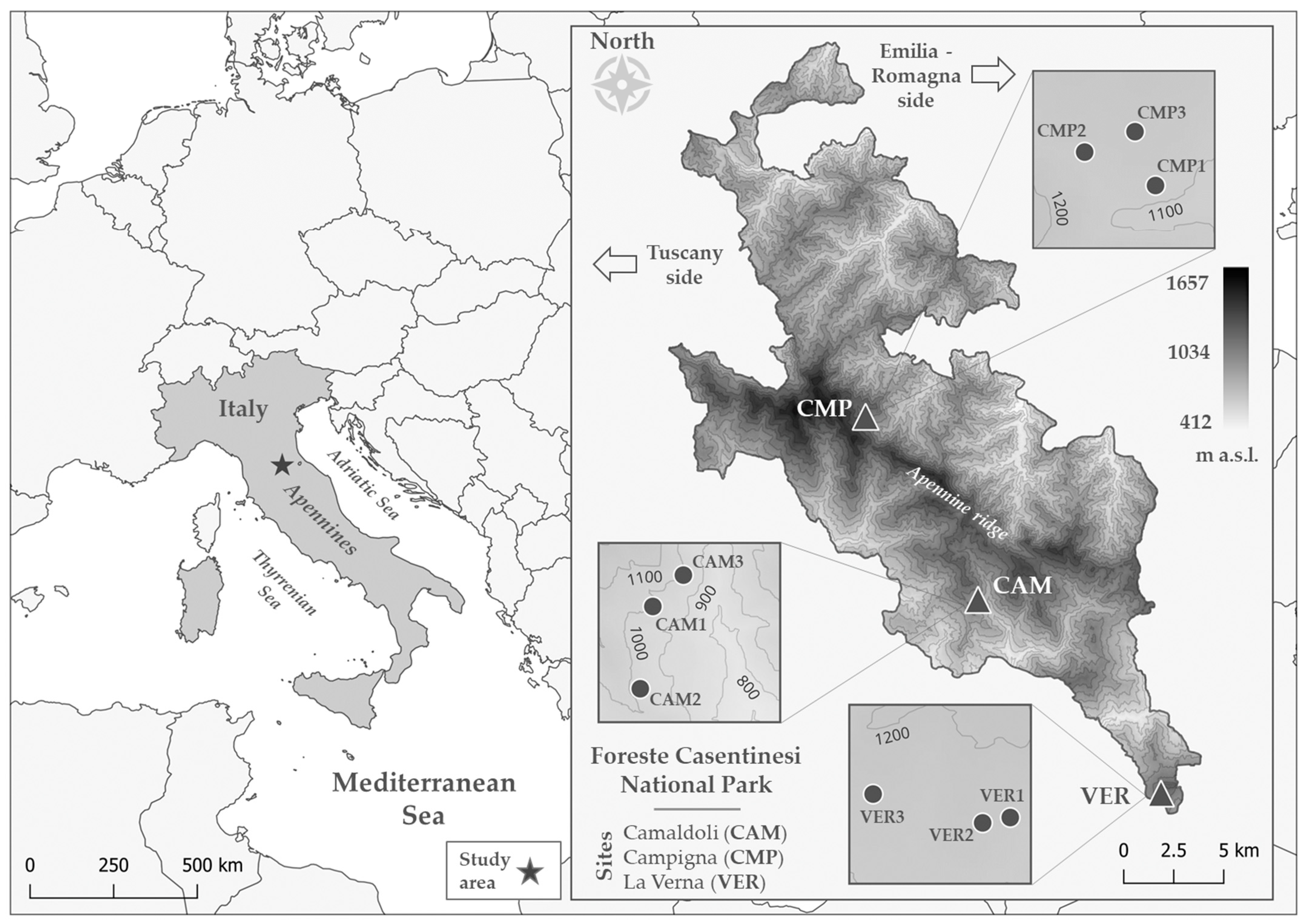

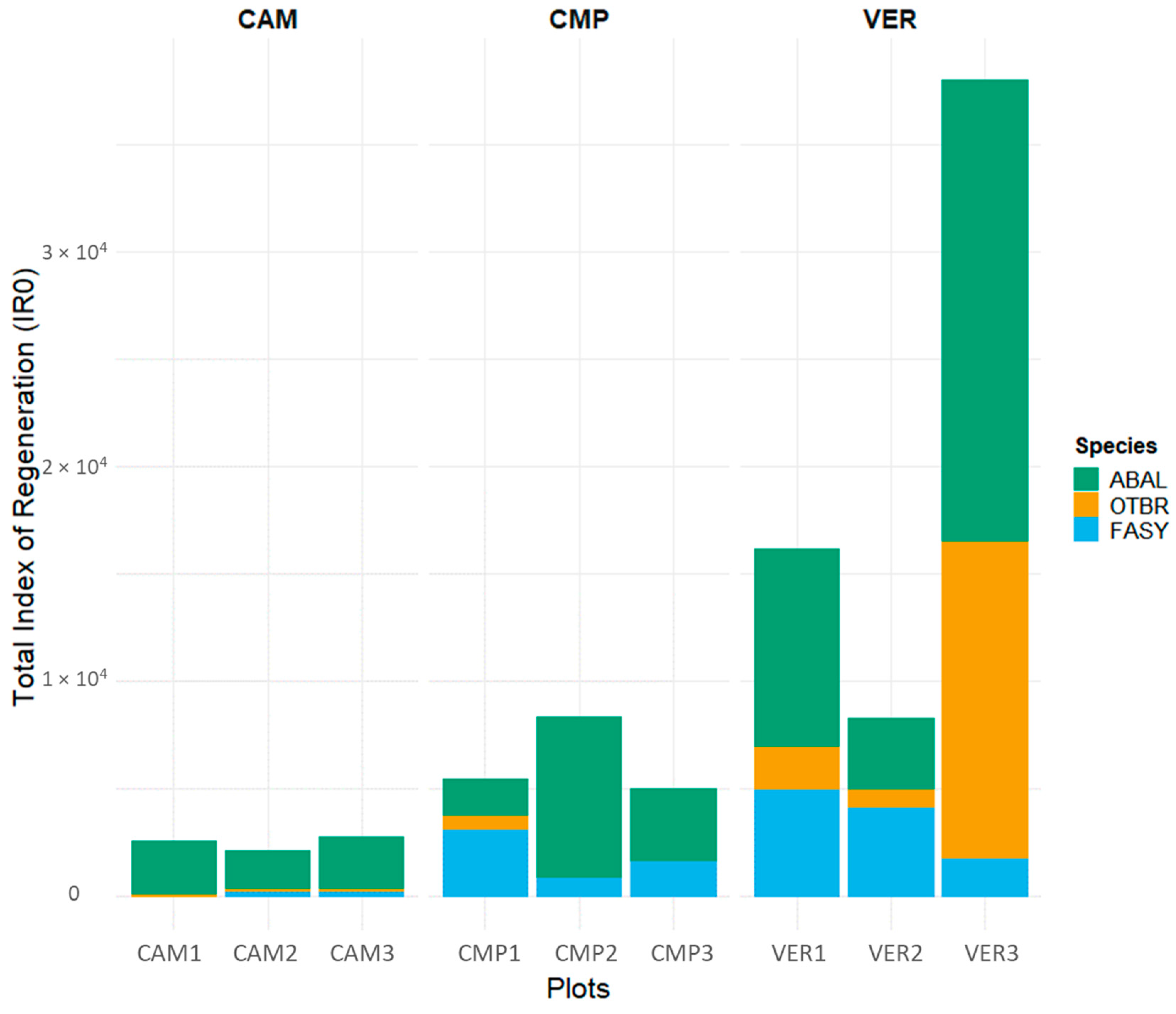


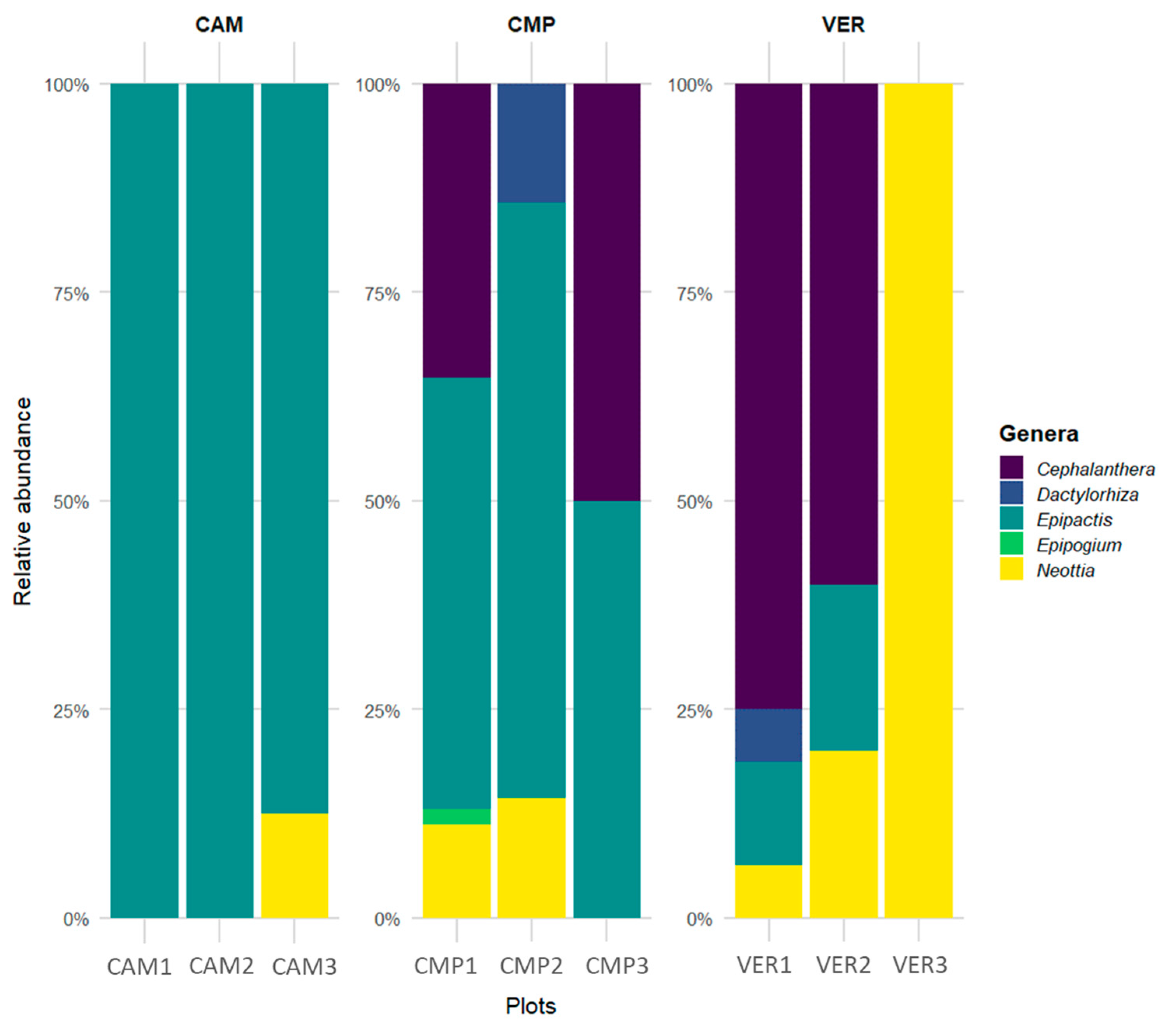
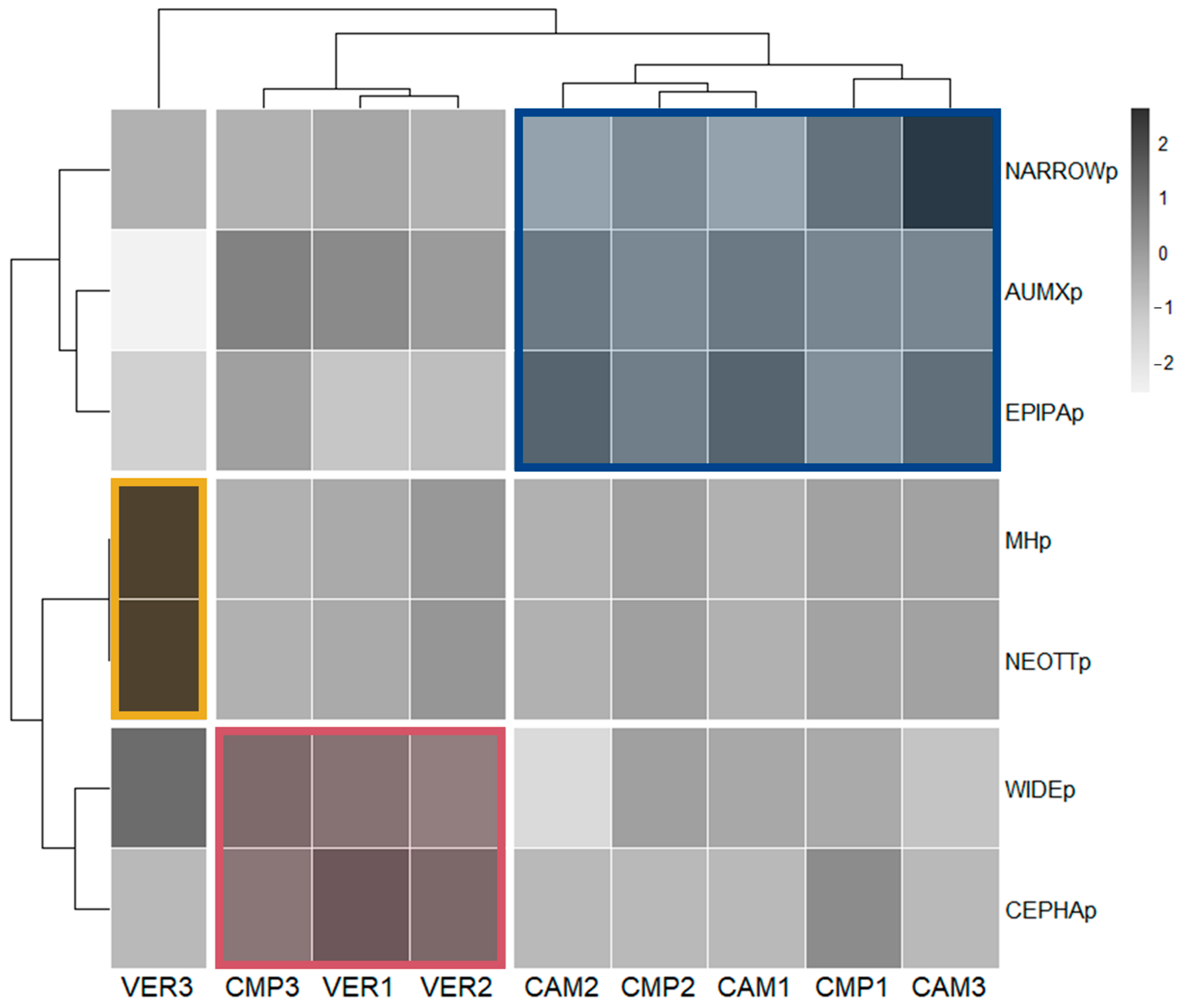
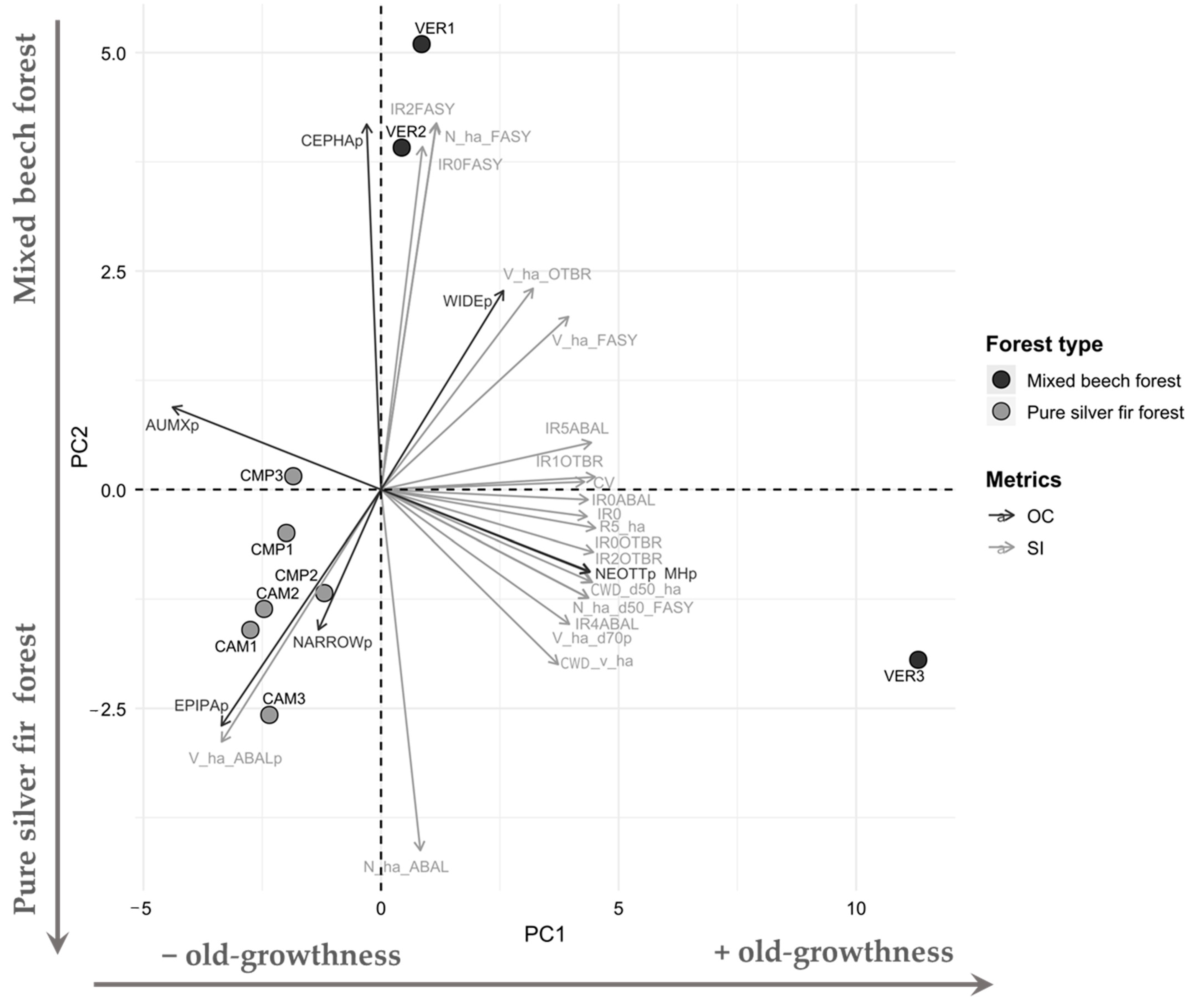

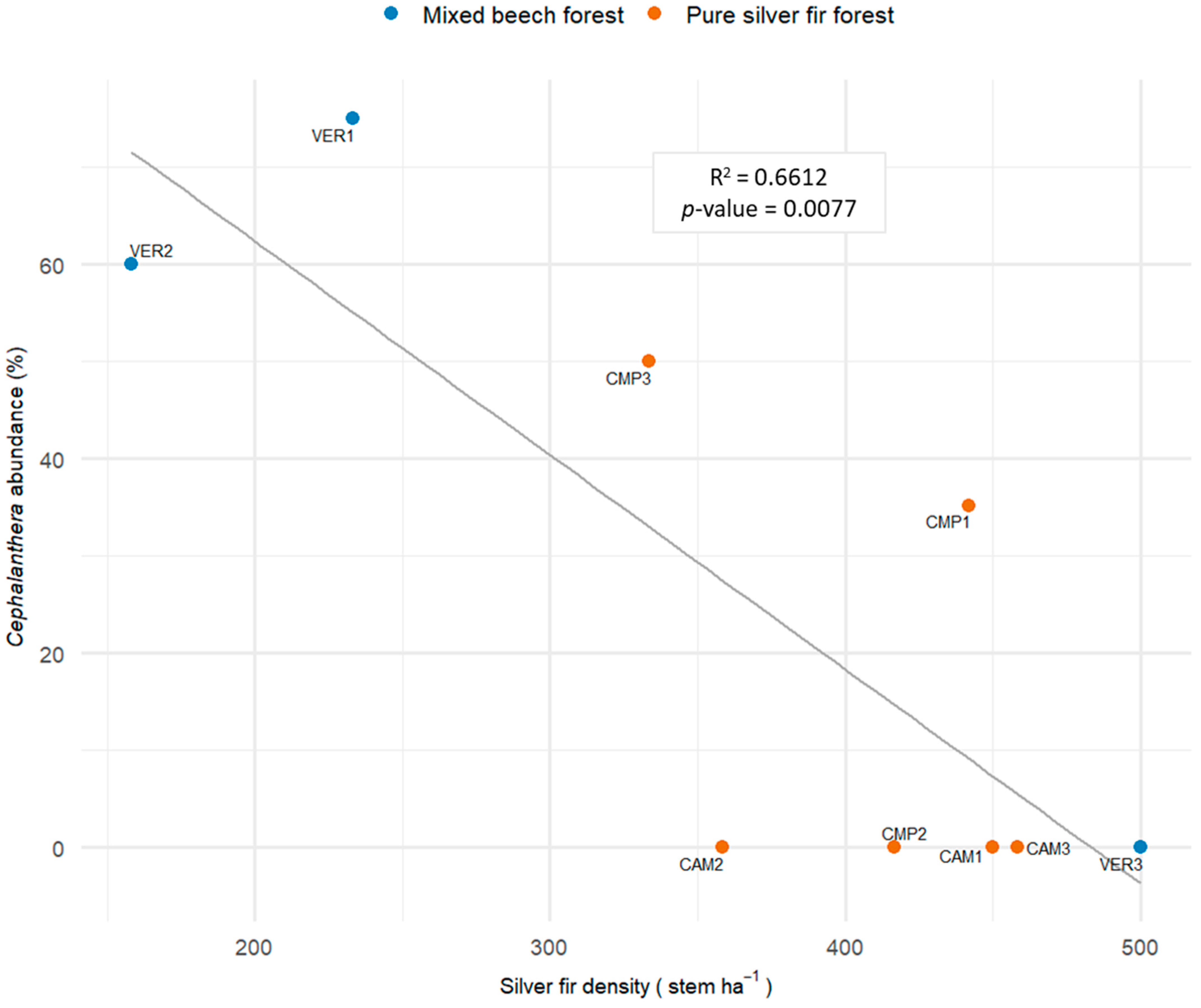


| Site | Code | Latitude (°N) | Longitude (°E) | Elevation (m a.s.l.) | Slope (%) | Aspect (°) |
|---|---|---|---|---|---|---|
| Camaldoli | CAM | 43.79151 | 11.81329 | 982 (956–1000) | 14 (9–20) | 125 (81–185) |
| Campigna | CMP | 43.87225 | 11.74016 | 1135 (1118–1159) | 22 (15–30) | 172 (152–195) |
| La Verna | VER | 43.70830 | 11.93217 | 1153 (1144–1161) | 19 (17–28) | 130 (100–180) |
| Genus | Code | Trophism | Species | Code | NP Distribution | Red List | Ellenberg Indicator Values | |||||
|---|---|---|---|---|---|---|---|---|---|---|---|---|
| L | T | K | F | R | N | |||||||
| Cephalanthera | CEPHA | AUMX | C. rubra (L.) Rich. | CERU | WIDE | LC | 3.0 | 5.0 | 5.0 | 4.0 | 8.0 | 3.0 |
| C. longifolia (L.) Fritsch | CELO | WIDE | LC | 4.0 | 5.0 | 5.0 | 3.0 | 8.0 | 3.0 | |||
| C. damasonium (Mill.) Druce | CEDA | WIDE | LC | 2.0 | 5.0 | 4.0 | 4.0 | 7.0 | 4.0 | |||
| Mean | 3.0 | 5.0 | 4.7 | 3.7 | 7.7 | 3.3 | ||||||
| Epipactis | EPIPA | AUMX | E. helleborine (L.) Crantz | EPHE | WIDE | LC | 3.0 | 5.0 | 5.0 | 5.0 | 7.0 | 5.0 |
| E. greuteri H. Baumann and Künkele | EPGR | NARROW | EN | 2.0 | 6.0 | - | 7.0 | 7.0 | 6.0 | |||
| E. microphylla (Ehrh.) Sw. | EPMI | WIDE | NT | 7.0 | 7.0 | 4.0 | 3.0 | 6.0 | 2.0 | |||
| E. leptochila (Godfery) Godfery | EPLE | NARROW | LC | 3.0 | 6.0 | 3.0 | 4.0 | 9.0 | 4.0 | |||
| E. purpurata Sm. | EPPU | NARROW | LC | 2.8 | 5.8 | - | 5.5 | 7.3 | 5.3 | |||
| E. exilis P. Delforge | EPEX | NARROW | LC | - | - | - | - | - | - | |||
| Mean | 3.6 | 6.0 | 4.0 | 4.9 | 7.3 | 4.5 | ||||||
| Neottia | NEOTT | MH | N. nidus-avis (L.) Rich. | NENA | WIDE | LC | 2.0 | 5.0 | 5.0 | 5.0 | 7.0 | 5.0 |
| Dactylorhiza | DACTY | AUMX | D. maculata (L.) Soó s.l. | DAMA | WIDE | LC | 7.0 | 5.0 | 5.0 | 5.0 | - | 4.0 |
| Epipogium | EPIPO | MH | E. aphyllum Sw. | EPAP | NARROW | LC | 1.0 | 4.0 | 5.0 | 5.0 | 3.0 | 9.0 |
| CAM | CMP | VER | ||
|---|---|---|---|---|
| Forest type | Pure silver fir | Pure silver fir | Mixed beech | |
| Living Trees | Stature (m) | 33.4 | 37.2 | 30.9 |
| DBH (cm) | 38.7 (34.9–44.3) | 45 (39.5–49) | 22.1 (19.6–25.1) | |
| Density (stem ha−1) | 483 (458–508) | 469 (358–583) | 772 (666–933) | |
| Basal Area (m2 ha−1) | 65 (55.4–75.4) | 83.4 (75.6–87.3) | 45.2 (43.3–48.6) | |
| Tree Volume (m3 ha−1) | 958.9 (772–1137.6) | 1345 (1246–1404.8) | 584 (481.1–726.5) | |
| Large Tree Volume (%) * | 5.5 | 14.4 | 21.1 | |
| Tree Species composition (% Volume) | ABAL | 98.8 | 98.7 | 24.7 |
| FASY | 1 | 0 | 63.7 | |
| OTBR | 0.2 | 1.3 | 11.6 | |
| Tree Index of Regeneration (%) | Small (IR1-2) | 96.5 | 64.6 | 34.8 |
| Intermediate (IR3) | 0 | 4.1 | 0.2 | |
| Established (IR4-5) | 3.5 | 31.3 | 65 | |
| Total Deadwood | Density (stem ha−1) | 202.8 (108.3–391.7) | 166.7 (75–283.3) | 83.3 (33.3–158.3) |
| Volume (m3 ha−1) | 76.6 (10.6–172.4) | 24.6 (14.4–36.5) | 42.2 (4.4–93.5) | |
| Coarse Woody Debris (CWD) | Density (stem ha−1) | 166.7 (0–391.7) | 136.1 (66.7–100) | 50 (33.3–75) |
| Volume (m3 ha−1) | 19.1 (0–46.7) | 10.1 (5.1–15.1) | 34.8 (3.4–93.5) | |
| Standing Dead Tree (SDT) | Density (stem ha−1) | 36.1 (0–108.3) | 30.6 (8.3–41.7) | 33.3 (0–83.3) |
| Volume (m3 ha−1) | 57.5 (0–172.4) | 14.5 (4.2–31.4) | 7.3 (0–20.9) |
| AIC Values | Goodness-of-Fit | |||||||
|---|---|---|---|---|---|---|---|---|
| LM | Poly2 | NLS | Final Model | |||||
| Univariate | Bivariate | Univariate | Bivariate | Univariate | Bivariate | R2 | p-Value | |
| Model 1 (Epipactis sp.pl.) | 83.19 | 84.03 | 83.59 | - | 83.87 | - | 0.76 | 0.0023 |
| Model 2 (Cephalanthera sp.pl.) | 82.42 | 84.39 | 84.41 | - | NA | - | 0.66 | 0.0077 |
| Model 3 (Mycoheterotrophic species) | 75.48 | - | 69.46 | - | 66.15 | NA | 0.95 | 0.0002 |
| Model 4 (Narrow range species) | 74.09 | - | 74.03 | 76.54 | NA | - | 0.78 | 0.0046 |
| Forest Features | Large Trees | CWD | Deadwood | Silver Fir | Preferred Forest Structure | |
|---|---|---|---|---|---|---|
| Values | % Volume | Volume (m3 ha−1) | Density (stem ha−1) | % Volume | Density (stem ha−1) | |
| Mycoheterotrophic species (abundance > 25%) | >30 | >55 | - | - | - | Complex, old-growth structure with decaying CWD |
| Narrow range species (abundance > 25%) | - | - | >270 | - | - | Mature, self-thinning/self-pruning pure fir |
| Cephalanthera (abundance > 50%) | - | - | - | - | <250 | Angiosperm dominant, scarce fir regeneration |
| Epipactis (abundance > 50%) | - | - | - | >70 | - | Mature, pure fir |
Disclaimer/Publisher’s Note: The statements, opinions and data contained in all publications are solely those of the individual author(s) and contributor(s) and not of MDPI and/or the editor(s). MDPI and/or the editor(s) disclaim responsibility for any injury to people or property resulting from any ideas, methods, instructions or products referred to in the content. |
© 2025 by the authors. Licensee MDPI, Basel, Switzerland. This article is an open access article distributed under the terms and conditions of the Creative Commons Attribution (CC BY) license (https://creativecommons.org/licenses/by/4.0/).
Share and Cite
Pica, A.; Schirone, B.; Magrini, S.; Laghi, P.; Cianfaglione, K.; Di Filippo, A. Naturalness and Tree Composition Determine the Abundance of Rare and Threatened Orchids in Mature and Old-Growth Abies alba Forests in the Northern Apennines (Italy). Land 2025, 14, 579. https://doi.org/10.3390/land14030579
Pica A, Schirone B, Magrini S, Laghi P, Cianfaglione K, Di Filippo A. Naturalness and Tree Composition Determine the Abundance of Rare and Threatened Orchids in Mature and Old-Growth Abies alba Forests in the Northern Apennines (Italy). Land. 2025; 14(3):579. https://doi.org/10.3390/land14030579
Chicago/Turabian StylePica, Antonio, Bartolomeo Schirone, Sara Magrini, Paolo Laghi, Kevin Cianfaglione, and Alfredo Di Filippo. 2025. "Naturalness and Tree Composition Determine the Abundance of Rare and Threatened Orchids in Mature and Old-Growth Abies alba Forests in the Northern Apennines (Italy)" Land 14, no. 3: 579. https://doi.org/10.3390/land14030579
APA StylePica, A., Schirone, B., Magrini, S., Laghi, P., Cianfaglione, K., & Di Filippo, A. (2025). Naturalness and Tree Composition Determine the Abundance of Rare and Threatened Orchids in Mature and Old-Growth Abies alba Forests in the Northern Apennines (Italy). Land, 14(3), 579. https://doi.org/10.3390/land14030579











